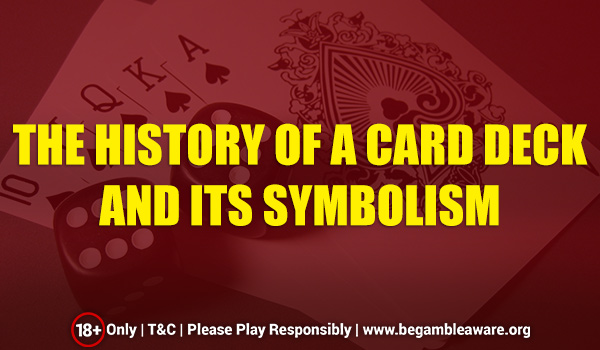Playing cards are available all over the globe and can be found everywhere except perhaps at the bottom of the Marianas Trench! The Precise History of a Card Deck and its original designers is not known with any certainty, though some theologians in the medieval era considered them to be the works of Satan that served to multiply sin.

Read on for a comprehensive and compelling story of the History of a Card Deck.
History of a Card Deck and the Symbolism of Playing Cards
Playing cards were supposedly invented by an ancient Egyptian god by the name of Dhauti. This old worthy apparently used the cards to teach folks about the four varied essential components of the universe, like air, fire, water and earth.
During the middle ages, the Jewish Kabbalists started reading meanings in the playing cards of the period. To them Diamonds referred to salamander spirits, Hearts referred to sylphs who were supposedly lords of the air, Clubs stood for water spirits known as undines and Spade’s reference gnomes who ruled the underground.
Other mystics however disagreed and suggested that the card suits all referred to separate aspects of human nature. Thus, Hearts refer to love, Diamonds refer to a passion for money and other materialistic things, Clubs refer to a hunger for knowledge and Spades suggest the spectre of death.
Other thinkers however held that the card decks reflected the time. Supposedly, the red and black colours used on the cards refer to the alternating motion of night and day, the 52 cards in a shoe referred to the number of weeks there are in a normal year, with the Joker representing a leap year. The quartet of card suits is also held to refer to the four different seasons of the year.
More Realistic Playing Cards Origins in the History of a Card Deck
If we are being practical, there are a couple of versions relating to the origin of playing cards that appear to be more plausible than what has been related above. In the first, the ancient Brahmins of India created playing cards around 800 AD. In yet another version, playing cards were invented in ancient China during the time of the Tang dynasty. This History of a Card Deck tends to make some sense.
Exactly when card decks showed up in Europe is unknown. Some attribute their presence to the crusades and the crusaders of the period, while others feel that the Saracen invasion of Italy was responsible.
Nevertheless, by 1254, Louis the Holy had grown so alarmed at the popularity of playing cards that he banned them in France.
It was in France that cards bearing the likeness of kings, queens and squires were invented after they were added due to the insistence of King Charles VI.
The earliest recorded European cards were known as Tarot cards. They had 4 suits and each set had 10 cards, along with numbers and a quartet of picture cards. The card set also included 22 trump cards, among which was the fool, which would be later known as the Joker.
As card games evolved, they became more complex. This among other varied factors gave rise to a strong backlash that resulted in the Tarot card deck being reduced in volume, leaving just 52 cards.
Card Characters in the History of a Card Deck
Card characters in the History of a Card Deck have undergone a phenomenal metamorphosis. The Thirty years War -1618- 1648- to the present, they have featured all manner of characters, from the absurd to the godly. All these, however, failed to stick, and today the drawings found on the picture cards are mere stylizations that look, unlike any actual historical figure.
However, card decks actually have a very rich historical symbolism, which most players fail to even consider when handling and having fun with them.
Author: Richard
Posted On: 30/05/2019
-
Roulette Vs Poker: Which One Gets the Tight Hold of the Crown?
You might be among the newcomers who have gained enough interest to get ...
-
Blackjack and Deck Penetration: A Secret to Card Counting
Blackjack is one of the most popular games among the gamblers who love t ...
-
Why Are Lottery Scratch cards Considered A ‘Hard’ Form Of Gambling?
The concept ...
